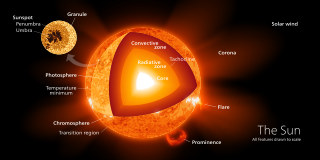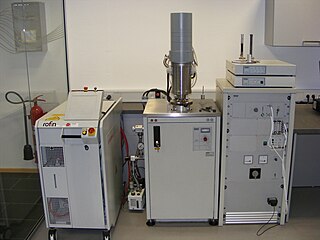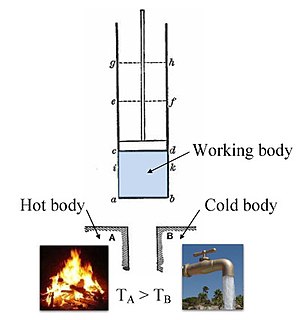This page is based on this
Wikipedia article Text is available under the
CC BY-SA 4.0 license; additional terms may apply.
Images, videos and audio are available under their respective licenses.
A semiconductor material has an electrical conductivity value falling between that of a metal, like copper, gold, etc. and an insulator, such as glass. Their resistance decreases as their temperature increases, which is behaviour opposite to that of a metal. Their conducting properties may be altered in useful ways by the deliberate, controlled introduction of impurities ("doping") into the crystal structure. Where two differently-doped regions exist in the same crystal, a semiconductor junction is created. The behavior of charge carriers which include electrons, ions and electron holes at these junctions is the basis of diodes, transistors and all modern electronics. Some examples of semiconductors are silicon, germanium, and gallium arsenide. After silicon, gallium arsenide is the second most common semiconductor used in laser diodes, solar cells, microwave frequency integrated circuits, and others. Silicon is a critical element for fabricating most electronic circuits.

The troposphere is the lowest layer of Earth's atmosphere, and is also where nearly all weather conditions take place. It contains approximately 75% of the atmosphere's mass and 99% of the total mass of water vapor and aerosols. The average height of the troposphere is 18 km in the tropics, 17 km in the middle latitudes, and 6 km in the polar regions in winter.
The total average height of the troposphere is 13 km.
The thermal conductivity of a material is a measure of its ability to conduct heat. It is commonly denoted by
,
, or
.
Electrical resistivity is a fundamental property of a material that quantifies how strongly that material opposes the flow of electric current. A low resistivity indicates a material that readily allows the flow of electric current. Resistivity is commonly represented by the Greek letter ρ (rho). The SI unit of electrical resistivity is the ohm-metre (Ω⋅m). As an example, if a 1 m × 1 m × 1 m solid cube of material has sheet contacts on two opposite faces, and the resistance between these contacts is 1 Ω, then the resistivity of the material is 1 Ω⋅m.

The first law of thermodynamics is a version of the law of conservation of energy, adapted for thermodynamic systems. The law of conservation of energy states that the total energy of an isolated system is constant; energy can be transformed from one form to another, but can be neither created nor destroyed. The first law is often formulated
The lapse rate is the rate at which an atmospheric variable, normally temperature in Earth's atmosphere, changes with altitude. Lapse rate arises from the word lapse, in the sense of a gradual change.
It corresponds to the vertical component of the spatial gradient of temperature.
Although this concept is most often applied to the Earth's troposphere, it can be extended to any gravitationally supported parcel of gas.
Conductivity may refer to:

Alpine climate is the average weather (climate) for the regions above the tree line. This climate is also referred to as a mountain climate or highland climate.

Stars of different mass and age have varying internal structures. Stellar structure models describe the internal structure of a star in detail and make detailed predictions about the luminosity, the color and the future evolution of the star.
A property of a physical system, such as the entropy of a gas, that stays approximately constant when changes occur slowly is called an adiabatic invariant. By this it is meant that if a system is varied between two end points, as the time for the variation between the end points is increased to infinity, the variation of an adiabatic invariant between the two end points goes to zero.
In the study of combustion, there are two types of adiabatic flame temperature depending on how the process is completed. These are constant volume and constant pressure, describing the temperature that the combustion products theoretically reach if no energy is lost to the outside environment.

In meteorology, convective instability or stability of an air mass refers to its ability to resist vertical motion. A stable atmosphere makes vertical movement difficult, and small vertical disturbances dampen out and disappear. In an unstable atmosphere, vertical air movements tend to become larger, resulting in turbulent airflow and convective activity. Instability can lead to significant turbulence, extensive vertical clouds, and severe weather such as thunderstorms.

The level of free convection (LFC) is the altitude in the atmosphere where the temperature of the environment decreases faster than the moist adiabatic lapse rate of a saturated air parcel at the same level.
Adiabatic quantum computation (AQC) is a form of quantum computing which relies on the adiabatic theorem to do calculations and is closely related to, and may be regarded as a subclass of, quantum annealing.
Adiabatic circuits are low power circuits which use "reversible logic" to conserve energy.

Conductivity of an electrolyte solution is a measure of its ability to conduct electricity. The SI unit of conductivity is Siemens per meter (S/m).

The laser flash analysis or laser flash method is used to measure thermal diffusivity of a variety of different materials. An energy pulse heats one side of a plane-parallel sample and the resulting time dependant temperature rise on the backside due to the energy input is detected. The higher the thermal diffusivity of the sample, the faster the energy reaches the backside. A state-of-the-art laser flash apparatus (LFA) to measure thermal diffusivity over a broad temperature range, is shown on the right hand side.

In solid-state physics, the valence band and conduction band are the bands closest to the Fermi level and thus determine the electrical conductivity of the solid. In non-metals, the valence band is the highest range of electron energies in which electrons are normally present at absolute zero temperature, while the conduction band is the lowest range of vacant electronic states. On a graph of the electronic band structure of a material, the valence band is located below the Fermi level, while the conduction band is located above it.









